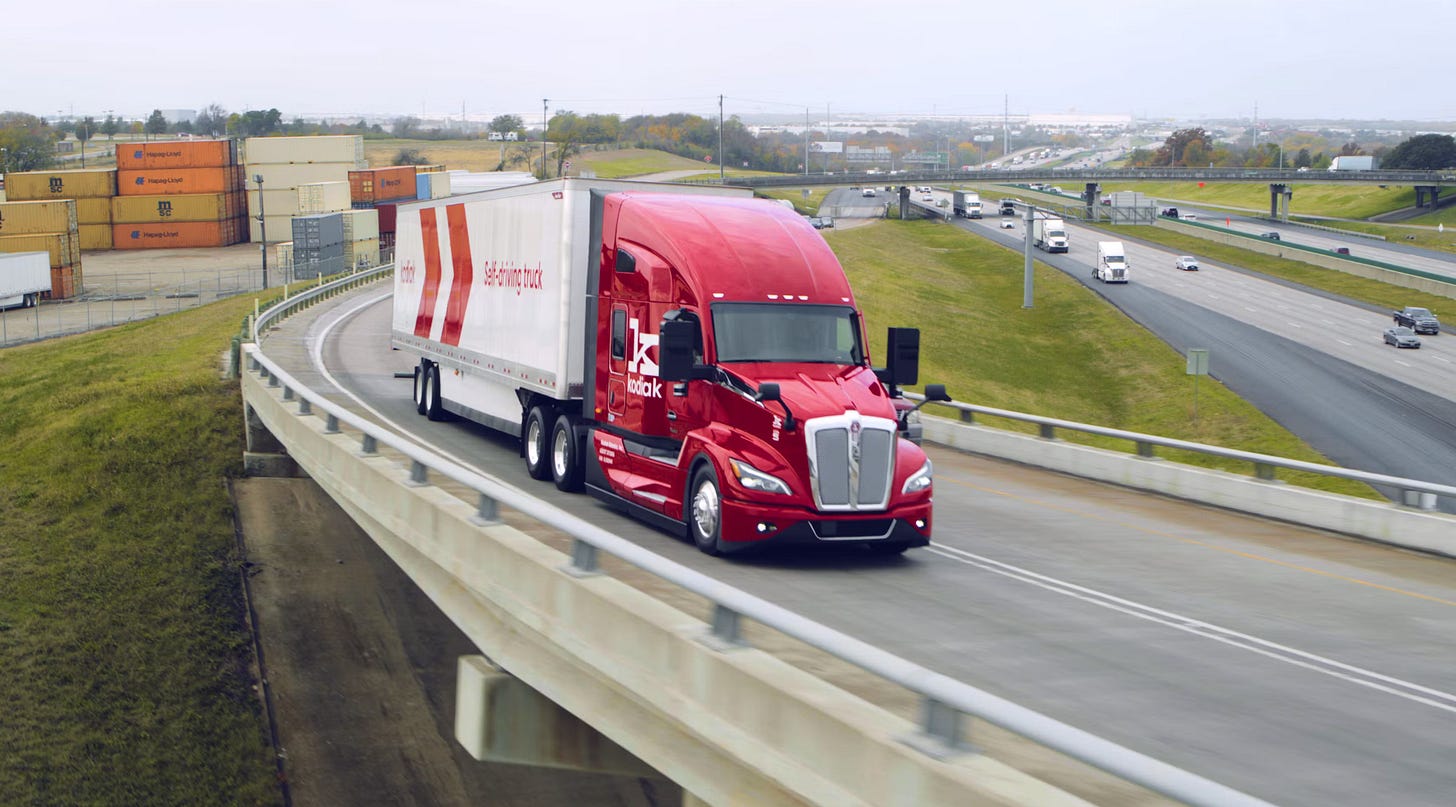🛡️Palantir Powers NATO AI; 🚚 Self-Driving Trucks SPAC; 🧠 Neuralink Rival Gets FDA Nod; 🚢 Autonomous Naval Ramps Up; 🧱 CO2 Cement Demo Launches | Deep Tech Briefing #57
Weekly Intelligence on Deep Tech Startups and Venture Capital.
Thanks for reading Deep Tech Briefing, our weekly intelligence on deep tech startups and venture capital. If you like what you see, I encourage you to subscribe to all our pieces here.
Dear Friends,
There’s a certain rhythm you start to hear once you’ve spent enough time around deep tech—not the noise of launches or funding rounds, but the subtler cadence of systems aligning.
This past week reinforced what’s becoming increasingly clear: the most important startups in the ecosystem aren’t the loudest. They’re the ones locking down permits, closing government contracts, installing hardware, and running live production. If you're still waiting for the “next wave,” it’s already happening—you’re just looking in the wrong places.
One second-wave autonomous mobility company, largely under the radar until now, finalized its path to the public markets. No media blitz, no Level 5 fantasy—just disciplined burn, a narrow use case, and real freight customers. It’s not a moonshot. That’s why it works.
In defense, at least two autonomy-focused startups made strategic moves. One took over a civilian shipyard to build unmanned surface systems at scale. Another emerged from stealth with a multi-domain autonomy stack—designed to operate without GPS and with minimal operator input. These aren’t just engineering projects. They’re procurement plays. And they’re being backed accordingly.
On the energy side, a geothermal platform quietly secured full offtake for a 500MW build. The win wasn’t in breakthrough tech—it was well optimization, modular deployment, and utility-grade economics. Another company in linear generators is now rolling out fuel-flexible systems that run sub-1500°C and switch between hydrogen, ammonia, and methane without hardware changes. The value? Grid resilience, without thermal penalties.
Then there’s the embodied AI wave. A humanoid robotics startup, recently aligned with a major open-source AI ecosystem, is testing modular kits priced for dev labs and light industrial use. Think “robot as API,” not spectacle. Meanwhile, another company’s foundation model stack is being tested for multi-agent autonomous operations—yes, in live field environments.
In advanced manufacturing, a Western European facility hit a production milestone: mineralizing captured carbon into construction-grade input materials. Another cement site was approved for full-scale emissions capture—expected to eliminate over 90% of annual process emissions. This isn’t a slide deck. It’s a physical retrofit of the industrial stack.
In materials, a stealth-stage team is scaling up isotope enrichment for critical applications in nuclear, aerospace, and advanced detection. They’re not pitching new physics. They’re commercializing legacy tech with modern engineering—and already running testbed units in modular format.
And for those tracking sovereign capability: Europe’s space agency has officially expanded its remit to include defense-aligned programs. That unlocks new commercial pathways in remote sensing, communications, and orbital infrastructure—especially for startups with dual-use tech but no prior channel into procurement.
The common thread? These companies aren’t selling potential. They’re building throughput. They know how to navigate infrastructure, supply chains, regulation, and production—not just technology risk. In today’s cycle, that’s the moat.
For investors, the message is simple: it’s not about the science anymore. It’s about who can deliver—on time, on budget, and at scale. The frontier is no longer where the idea begins. It’s where the output flows.
The next decade will belong to those who can industrialize—not just innovate.
Let’s dive in.
✨ For more, see Membership | VC Guides | Insights | Deep Tech Catalyst
In Today's Briefing
The Big Idea – A $2.5B autonomous trucking move just reframed what second-wave autonomy looks like. It's not about moonshots—it's about real metrics, patient capital, and vertical focus. The bigger signal? What it tells us about where SPACs go next.
The Key Updates – A naval autonomy player just locked in U.S. production scale. NATO fast-tracks an AI battlefield layer. A Neuralink rival clears FDA. Hugging Face makes a full-stack robotics play. And one stealth company you probably haven’t heard of—until now—just dropped a defense-native foundation model.
Deep Tech Power Plays – Ireland hedges trade through Asia. France shifts its hydrogen posture from scale to realism. ESA enters the defense orbit. The Pentagon bets on tactical microreactors—and rewrites procurement for speed.
Breakthroughs and Discoveries – Gallium oxide goes sovereign in Europe. Drones get 3D-printed at the edge. CMOS behaves like a brain. Graphene breaks into carbon capture. And a tire-to-epoxy pipeline could flip industrial recycling economics.
✨ INTRODUCING RUMORS!!!
The Silent Gold Rush of AI-Powered Lab Automation
✨ Rumors is an intelligence on emerging micro-trends in deep tech where we follow the money, the people, and the patterns across Deep Tech before they get mainstream.
Each edition is an early lens. A pattern-recognition layer for investors, founders, and operators who care about where the frontier is heading—before the narrative hardens.
In this first edition of Rumors, we dive into a quiet but accelerating movement reshaping the foundations of scientific research: The rise of AI-powered lab automation.
Here’s what we cover:
Why AI-for-labs is happening now
Five startups leading this movement, from Boston to Munich
The capital flowing into the thesis ($250M+ in the last 18 months)
What could go right (or wrong), and how to think about risk
Interesting Reading:
The deeper you dig, the weirder, wider, and more telling the world of deep tech becomes. Here are a few standout reads from this week:
Trump Administration Makes Deep-Tech Bets as Agencies Lean Into Quantum for National Security, Infrastructure, and Space – U.S. federal agencies are quietly scaling their commitment to quantum computing, marking a notable shift in how Washington defines national competitiveness. The Quantum Insider
Is Geothermal the New Zero-Carbon Answer to US Power Needs? – Once niche, geothermal is gaining traction as tech and policy converge—offering baseload clean power without the intermittency problem. Financial Times
Big Tech Has Officially Entered the Quantum Era – After years of promise, quantum hardware and software are seeing real traction—attracting serious enterprise interest and new layers of platform strategy. Business Insider
Entire Pentagon Defense Tech Unit to Leave by May – The sudden exit of DIU leadership signals deeper tensions around the future of defense innovation—and who controls it. The Hill
Space Force Eases Entry for Commercial Firms With Layered Launch Standards – A new regulatory playbook aims to accelerate commercial involvement in orbital launches—potentially reshaping the dual-use satellite market. SpaceNews
The Bitter Pill of Reliance on China for Drugs – A reminder that national security concerns extend well beyond chips and satellites—into APIs, generics, and critical pharma infrastructure. The Wall Street Journal
Startups Scramble to Mitigate Tariff Pain – With trade policy turning fast, early-stage hardware and climate startups are learning the hard way how exposed they really are. The Wall Street Journal
Tariff Upheaval Threatens Private Equity’s Exit Recovery Hopes – A warning shot for growth-stage operators: macro volatility could redraw exit timelines across the industrial stack. The Wall Street Journal
Private Equity Sponsors Consider Alternatives to 'China Plus One' Supply Chain Strategy – The supply chain realignment continues, but real alternatives require real infrastructure—not just strategy memos. PitchBook
Apple Supplier Luxshare Weighs Manufacturing in U.S. to Tackle Tariffs – Hardware players are reassessing cost vs. control as political pressure reshapes global manufacturing maps. Reuters
Volkswagen’s Scania Buys Bankrupt Northvolt’s Heavy Industry Battery Packs Unit – Consolidation in industrial batteries hints at the capital intensity—and fragility—behind the clean energy transition. Reuters
Phase Two of Military AI Has Arrived – Defense AI is moving from demo to deployment. The next challenge: integrating these tools at speed and scale. MIT Technology Review
How the Trump Administration Could Reshape America’s Food Industry – Agriculture tech may be the next frontier in the policy-industrial complex. Forbes
Before Go Ahead:
Deep Tech Briefing is just one part of The Scenarionist experience. To enjoy the full experience, become a Premium Member!
The Scenarionist Premium is designed to make you a better Deep Tech Founder, Investor, and Operator. Premium members gain exclusive access to unique insights, analysis, and Venture Guides with the wisdom of the world’s leading Deep Tech thought leaders. Invest in yourself, and upgrade today!
The Big Idea:
Kodiak Robotics Goes Public in $2.5 Billion SPAC Deal, Signaling New Phase for Autonomous Trucking
Over the past few years, the autonomous driving sector has followed a trajectory that could have been scripted in Hollywood: bold promises, billions in funding, dramatic setbacks, and now, what looks like a cautious but tangible second wave.
The news that Kodiak Robotics is going public via a $2.5 billion SPAC deal fits squarely into this context—as a signal, maybe even a structural one, in a still-uncertain market.
Kodiak is one of the few autonomous trucking players still standing after well-known names like TuSimple and Embark shut down U.S. operations, leaving behind skepticism and sky-high burn rates. Founded in 2018 by Don Burnette—a veteran of the self-driving world with experience at Google and the controversial startup Otto (later acquired by Uber)—Kodiak has taken a more measured approach: building its tech in-house, focusing on specific freight corridors like the Permian Basin, working with paying customers, and retrofitting existing trucks rather than building new platforms from scratch.
The deal with Ares Acquisition Corp II will bring $551 million in cash held in trust, plus another $110 million in committed funding from institutional investors like ARK, Ares, and Soros Fund Management. In a market that has seen a steep drop in IPO activity—only 21 VC-backed mobility tech companies went public in 2024, compared to 67 during the 2021 SPAC boom, according to PitchBook—this move could serve as a meaningful litmus test for the sector’s resilience.
So why now?







